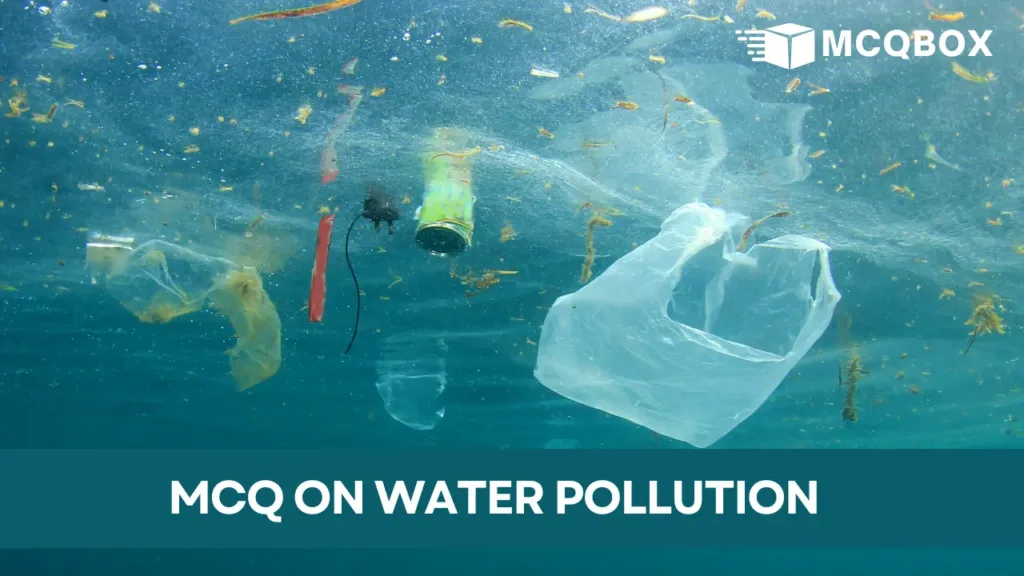Want to test your knowledge on water pollution? Try out the MCQ on Water Pollution below and see how much you know about this critical issue!
Table of Contents
What is Water pollution?
Water is a precious resource that sustains life on Earth. However, with industrialization and modern living, water pollution has become a pressing concern, threatening the delicate balance of ecosystems. In this article, we will explore the nuances of water pollution, its various types, causes, and the critical need to address this environmental challenge.
Types of Water Pollution
Water pollution comes in different forms, primarily categorized as point source and non-point source pollution. Point source pollution originates from identifiable sources like factories, while non-point source pollution is diffuse and often results from activities like agricultural and urban runoff. Let’s delve deeper into these categories.
Point Source Pollution
Point-source pollution refers to pollutants entering water bodies from specific, identifiable sources. Factories discharging untreated effluents into rivers or lakes are classic examples of point source pollution. This direct and traceable contamination demands targeted intervention to mitigate its impact.
Non-Point Source Pollution
On the other hand, non-point source pollution is more challenging to control as it arises from diffuse origins. Agricultural runoff, a significant contributor, introduces pollutants like pesticides and fertilizers into water bodies. Similarly, urban runoff carries contaminants such as oil and heavy metals. Understanding these subcategories is vital for developing effective pollution control strategies.
Causes of Water Pollution
To address water pollution comprehensively, it’s essential to identify its root causes. Industrial discharges, often laden with harmful chemicals, pose a severe threat. Agricultural activities contribute through the extensive use of pesticides and fertilizers, leading to runoff that adversely affects water quality. Additionally, improper waste disposal, especially the pervasive issue of plastic pollution, compounds the problem.
Effects of Water Pollution
Water pollution has far-reaching consequences, impacting both aquatic ecosystems and human health. Marine life suffers from contaminated oceans, while freshwater habitats face degradation. Humans, relying on water for sustenance, face health risks through drinking water contamination and the spread of waterborne diseases.
Global Water Pollution Concerns
The scope of water pollution extends beyond borders, affecting international water bodies and transboundary rivers. The degradation of oceans and seas is a global concern, necessitating collaborative efforts and stringent environmental policies.
Prevention and Mitigation Strategies
Addressing water pollution requires a multi-faceted approach. Embracing sustainable practices, implementing advanced water treatment technologies, and fostering public awareness and education are crucial strategies. These efforts aim to prevent further pollution and rehabilitate already affected water bodies.

MCQ on Water Pollution
1. What is the primary source of water pollution?
a) Natural processes
b) Industrial discharges
c) Agricultural runoff
d) All of the above
Answer 1: d) All of the above
2. Which of the following is a non-point source of water pollution?
a) Industrial effluent
b) Sewage treatment plant discharge
c) Pesticide runoff from fields
d) Oil spills from a tanker
Answer 2: c) Pesticide runoff from fields
3. Which pollutant is responsible for causing eutrophication in water bodies?
a) Heavy metals
b) Nitrogen and phosphorus
c) Organic pollutants
d) Radioactive substances
Answer 3: b) Nitrogen and phosphorus
4. What is the main impact of thermal pollution on aquatic ecosystems?
a) Increased dissolved oxygen levels
b) Decreased water temperature
c) Enhanced growth of aquatic plants
d) Harm to aquatic organisms due to elevated temperatures
Answer 4: d) Harm to aquatic organisms due to elevated temperatures
5. Which waterborne disease is caused by the consumption of contaminated water with fecal matter?
a) Malaria
b) Cholera
c) Tuberculosis
d) Dengue
Answer 5: b) Cholera
6. What is the term for the process of removing salt from seawater to make it suitable for drinking and irrigation?
a) Desalination
b) Filtration
c) Distillation
d) Sedimentation
Answer 6: a) Desalination
7. Which of the following methods is effective in controlling oil spills in water bodies?
a) Using chemical dispersants
b) Igniting the oil slick
c) Allowing natural dispersion
d) Placing physical barriers
Answer 7: d) Placing physical barriers
8. What is the significance of the Biochemical Oxygen Demand (BOD) parameter in water quality assessment?
a) Measures the concentration of heavy metals
b) Indicates the level of organic pollution
c) Determines the acidity of water
d) Measures the turbidity of water
Answer 8: b) Indicates the level of organic pollution
9. What does BOD stand for in the context of water quality assessment?
a) Biochemical Organic Dispersion
b) Biological Oxygen Demand
c) Basic Oxygen Deficiency
d) Bacterial Organic Decomposition
Answer 9: b) Biological Oxygen Demand
10. What does COD mean in water analysis?
a) Chemical Organic Decomposition
b) Carbon Oxygen Dissolution
c) Chemical Oxygen Demand
d) Carbonic Oxygen Decomposition
Answer 10: c) Chemical Oxygen Demand
Also see- MCQ on Air pollution